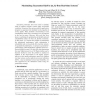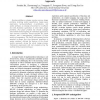RTCSA
2006
IEEE
14 years 5 months ago
2006
IEEE
(m,k)-firm constraints have been used to schedule tasks in soft/firm real-time systems under overloaded conditions. In general, they are provided by application designers to guara...
RTCSA
2006
IEEE
14 years 5 months ago
2006
IEEE
In this paper we analyze the traditional model of interrupt management and its inability to incorporate the reliability and temporal predictability demanded by real-time systems. ...
RTCSA
2006
IEEE
14 years 5 months ago
2006
IEEE
Real-time embedded systems are increasingly being networked. In distributed real-time embedded applications, e.g., electric grid management and command and control applications, i...
RTCSA
2006
IEEE
14 years 5 months ago
2006
IEEE
The modeling approach is not used to its full potential in maintenance of legacy systems. Often, models do not even exist. The main reasons being that the economic implications an...
RTCSA
2006
IEEE
14 years 5 months ago
2006
IEEE
From a real-time perspective, the Garbage Collector (GC) introduces unpredictable pauses that are not tolerated by real-time tasks. Real-time collectors eliminate this problem but...
RTCSA
2006
IEEE
14 years 5 months ago
2006
IEEE
In ubiquitous computing environments, contextawareness is one of the most important research topics. Computers embedded in our surrounding can extract information about a user, an...
RTCSA
2006
IEEE
14 years 5 months ago
2006
IEEE
Hardware/software codesign involves various design problems including system specification, design space exploration, hardware/software co-verification, and system synthesis. A co...
RTCSA
2006
IEEE
14 years 5 months ago
2006
IEEE
In this paper we consider data freshness and overload handling in embedded systems. The requirements on data management and overload handling are derived from an engine control so...
RTCSA
2006
IEEE
14 years 5 months ago
2006
IEEE
To build a “correct” implementation from a model of a concurrent real-time system, it is important to understand the relation between the properties of the model and of its co...
RTCSA
2006
IEEE
14 years 5 months ago
2006
IEEE
The load parameter of a sporadic task system is defined to be the largest possible cumulative execution requirement that can be generated by jobs of the task system over any time...


